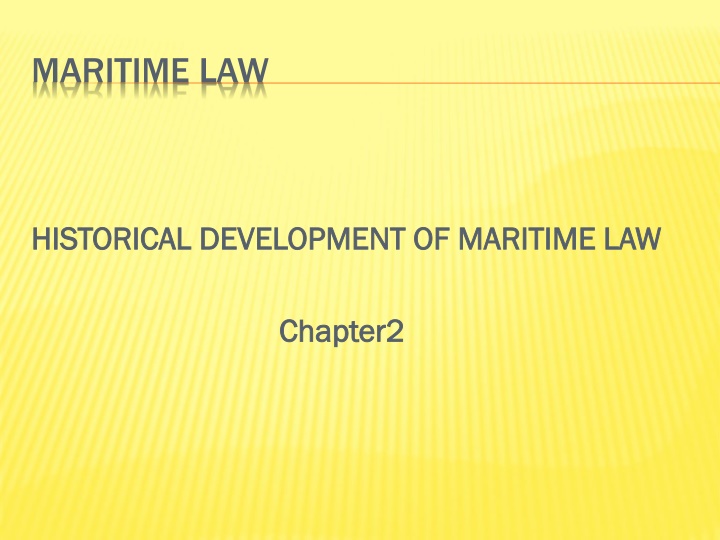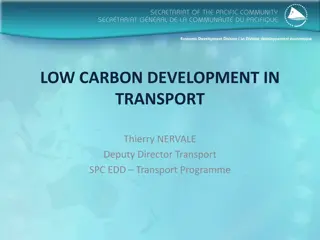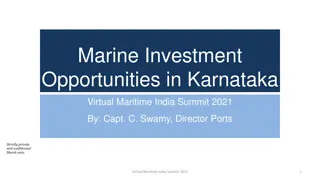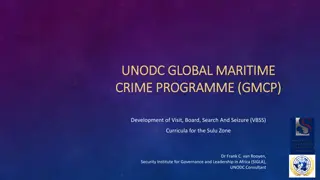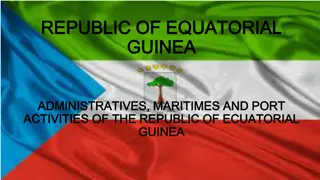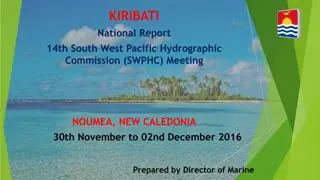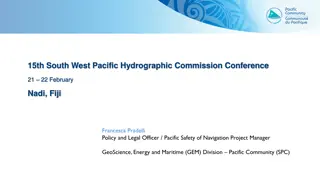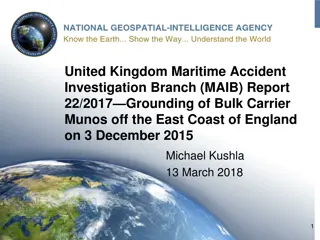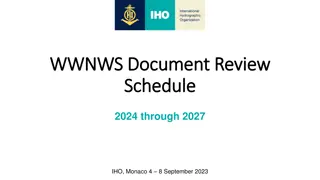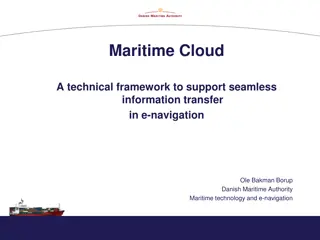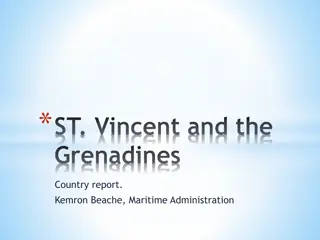Historical Development of Maritime Law
Transportation of goods and passengers by water has been crucial for international trade since ancient times. Explore the evolution of maritime law from ancient Egyptian and Greek customs to the formulation of notable maritime codes in Europe during the 1st millennium BC onwards.
Download Presentation

Please find below an Image/Link to download the presentation.
The content on the website is provided AS IS for your information and personal use only. It may not be sold, licensed, or shared on other websites without obtaining consent from the author.If you encounter any issues during the download, it is possible that the publisher has removed the file from their server.
You are allowed to download the files provided on this website for personal or commercial use, subject to the condition that they are used lawfully. All files are the property of their respective owners.
The content on the website is provided AS IS for your information and personal use only. It may not be sold, licensed, or shared on other websites without obtaining consent from the author.
E N D
Presentation Transcript
MARITIME LAW HISTORICAL DEVELOPMENT OF MARITIME LAW HISTORICAL DEVELOPMENT OF MARITIME LAW Chapter Chapter2 2
INTRODUCTION Transportation of goods and passengers by water is one of the most ancient channels of commerce on record. This mode of transportation was and still is indispensable for international trade since ships are capable of carrying bulky goods which otherwise would not be carried.
CONT Rules governing relationships among participants of sea-transport have also been known since.1st millennium BC. Ancient maritime rules derived from the customs of the early Egyptians, and the Greeks who carried an extensive commerce in the Mediterranean Sea.
CONT The earliest maritime code is credited to the island of Rhodes. It is generally accepted that the earliest maritime laws were the Rhodian Sea Laws, which have been claimed to date from 900 B.C., but which more likely appeared in the form recognized today during the period from 500 to 300 B.C.
CONT Although the decline of Greece and the rise of the Roman Empire did alter the influence of the Rhodian Sea Law, a uniform code based on the Rhodian Law remained and was recognized as essential to peaceful and profitable Mediterranean trade. The Mediterranean Sea was for more than one thousand years [300 B.C. to 1200 A.D.] only ruled by the Rhodian Law, although augmented with some additions by the Romans.
CONT Special tribunals were set up in the Mediterranean port towns to judge disputes arising among seafarers. This activity eventually led to the recording of individual judgments and the codification of customary rules by which courts become bound.
CONT Three noted codes of maritime law whose principles were found in the Roman law, were formulated in Europe during the three centuries between A.D. 1000 and A.D. 1300. One, Libre del Consolat de mar of Barcellona was adopted by the cities on the Mediterranean; the second, the Laws of Oleron prevailed in France and England; and the third, Laws of Wisby governed the great free cities of the Baltic.
CONT The oldest of these codes was Consolato del Mare, or Regulation of the Sea, prepared at Barcelona. It was a compilation of comprehensive rules for all maritime subjects. It, for example, dealt with ownership of vessels, the duties and responsibilities of the masters or captains , duties of seamen and their wages, freight, salvage, jettison, average contribution, and the like.
CONT In essence, until the rise of modern nations, maritime law did not derive its force from territorial sovereigns but represented what was already conceived to be the customary law of the sea.
CONT Eventually, as commerce from the Mediterranean moved northward and westward, sea codes developed in northern European ports. Among the important medieval sea codes were the Laws of Wisby (a Baltic port), the Laws of Hansa Towns (a Germanic league), and the Laws of Oleron (in France). The Consolato del Mare was inspirational in the preparation of these later codes.
CONT These three codes are called the three arches upon which rests modern admiralty structure.
CONT The European admiralty doctrines were carried to the USA another important shipping nation through the English system of admiralty law, which initially was inspired by what have been termed the three arches of modern admiralty law the Laws of Wisby, the Laws of Hansa Towns, and the Laws of Oleron.
CONT Contemporary maritime law is a mixture of ancient doctrines and new at laws both national and international. Among the traditional principles of admiralty still in use are marine insurance, general average and salvage.
CONT The main reason for the continuous use of ancient principles of law is the unchanging nature of basic hazards of seafaring . Since at least the end of the 19thcentury, however, naval architecture have changed in significant ways. The extensive use of crude oil carriers as well as carriers of natural gas has, for example, posed new hazards and questions of liability for oil pollution.
CONT As a result of this, modern maritime law consists of laws that are of historic origin and of recent development. Note also that not all of the original principles of maritime law still apply.
CONT The earliest known maritime laws were uniform. This historical uniformity of early maritime laws declined with the growth of nationalism.
CONT However, maritime transactions have always been international in nature which most of the time involve individuals from different jurisdictions. International shipping is a complex business, and its activities are conducted in a manner that often implicates the interest of several countries.
CONT Making the rules of maritime law universally uniform, would alleviate most of the problems related to unpredictability and conflict of laws. This understanding has led to the revival in the nineteenth century to make rules relating to maritime transaction uniform globally.
CONT This effort was first started at the instigation of lawyers and commercial men such as those who founded the Committee Maritime International (CMI) and the national maritime law associations; and continues to grow under the aegis of the Intergovernmental Maritime Organization (IMO) and other United Nations affiliated organizations with the cooperation of experts in the private sector.
CONT Founded in 1897, the International Maritime Committee or CMI initiated uniformity among national maritime legislations of member countries. Among the conventions drafted by CMI were the Hague Rules (International Convention on Bill of Lading), and the Visby Amendments (amending the Hague Rules), the Salvage Convention and many others.
CONT Since 1958, many of CMI s functions have been taken by the International Maritime Organization of the UNO. This organization has also continued the move towards uniform maritime laws. Many states adhered to this rules either by incorporation of the provisions in domestic laws or by implication of treaty obligations.
CONT Thus, now, we can speak of the relative uniformity of national maritime laws of different shipping states which may not be matched by the degree of uniformity attained in some other areas of law. The degree of harmonization so far attained is not, however, satisfactory in so far as some areas are concerned. For example, there still exists differences in assessment of maritime claims.
